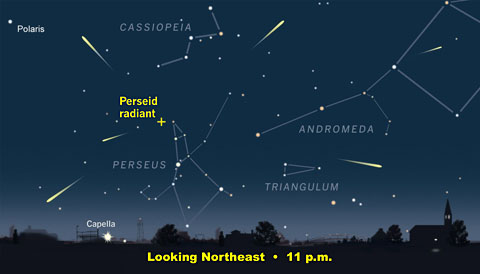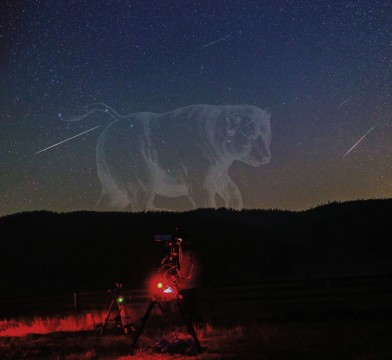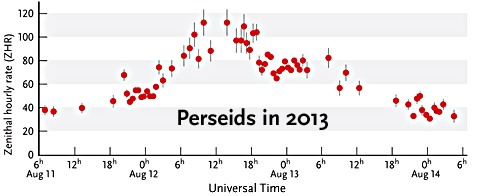This year there's no Moon, and the Perseid meteor shower should peak at just the right time for North America.
Every three years, more or less, the Moon is new around the peak night of the Perseid meteor shower — and it's that time again. New Moon falls on August 14th, which gives us a dark sky for the entire prime Perseid night, August 12–13, as well as good meteor watching for several nights before and after.

Sky & Telescope diagram
Moreover, the shower's exact peak is predicted to run for several hours centered on 8h Universal Time on August 13th (4 a.m. EDT, 1 a.m. PDT). This coincides with the best meteor-watching hours — from late evening to the first light of dawn — in the time zones of North America. The late-night hours are when the shower's radiant point (in northern Perseus) rises high in the sky. Or to say the same thing another way, that's when the meteors hit your side of the world most nearly head-on.
There's an added twist this year. The Perseid meteoroids are little bits of debris from Comet 109P/Swift-Tuttle, which has a looping, 130-year orbit that last brought it through the inner solar system in 1992. Meteor-stream modeller Jérémie Vaubaillon finds that this year, Earth should pass very close to the debris trail that the comet shed during its return three orbits earlier, in 1862. This encounter will last for a few hours on August 12th centered at 18:39 UT. Will there be an unscheduled outburst of Perseids? The timing favors observers in Asia. Meteor counters on that side of the world are especially needed to monitor what happens.
How To Watch

Alex Conu
It's easy just to be a Perseid spectator. Many more people watch the shower now than did a generation or two ago, especially families on rural vacations. In fact, America's national parks are getting unprecedented numbers of people who say that seeing the stars in a dark, natural sky and experiencing genuine night are important reasons why they visit. For this we can credit the growing public awareness of light pollution (with big thanks to the International Dark-Sky Association) and the park system's own management, which is recognizing and working to preserve the dark-sky assets.
But a Perseid watch goes best if you know what you're doing. The later in the night you go out the better — and plan to be patient. After midnight under a fairly rural sky you might see a meteor a minute on average, but earlier in the evening or under more ordinary skies, your waits will be longer.
Dress warmly and wear a hat. The temperature under a clear August sky late at night will be like October, and you'll be lying still for a long time. Find a place in advance with an open view overhead, with no glaring lights shining into in the edge of your vision. Bring a reclining lawn chair and additional blankets or a sleeping bag. The wraps are for both warmth and mosquito protection; bring repellent for parts of you not covered. Lie back and gaze into sky's the darkest part, preferably inclining a bit toward the radiant in the northeast. Relax and settle in.
Some meteor aficionados plan to flout the standard wisdom and watch early in the evening. At that time, when the shower's radiant is still low above the horizon, the few Perseids that do appear will be spectacularly long "Earthgrazers," skimming far across the sky along the top of the atmosphere.
Making a Count
If you have a moderately dark sky and an hour or more to commit, why not try doing a genuine, scientific meteor count? This way you can help to determine the shower's behavior this year, contributing to records that will last for all time.

Source: IMO
You'll need to follow the standard procedures of the International Meteor Organization, so that your count can be analyzed to yield the shower's true strength (what's called the zenithal hourly rate or ZHR) during the time you were watching. The ZHR is the number of meteors that a single observer would see if the radiant were at the zenith and the sky were dark enough for stars as faint as magnitude 6½ to be visible.
Mkaing a meteor count can be very rewarding, and I offer more tips about it here. But even casual skywatchers can appreciate that the Perseids are one of very best displays you'll see all year. With conditions so optimal in 2015, don't miss it!
For a comprehensive guide to meteor showers and other upcoming sky events, one that S&T's editors use every day, get the indispensable RASC Observer's Handbook 2015.
 2
2









Comments
Tom Hoffelder
August 12, 2015 at 10:06 am
Thank you for mentioning Earthgrazers! Most articles say watch after midnight. To me, one earthgrazer is worth about 50 of the meteors you'll see after midnight!
You must be logged in to post a comment.
JimStars
August 13, 2015 at 2:25 pm
One observation on all the comments read elsewhere all over the media about The Perseids. As with comments about food recipes, 90% of comments about Meteor showers are always of the form: It should be a great night or it IS a great night or it looks like a wonderful night or it WAS a great night for viewing. But nobody actually in fact went out and viewed them (just like people hardly ever actually make a recipe -- but still comment on how good it looks and must taste).
Well for this Perseids watcher, in spite of all the hype, from 12:30-1:30AM in the northeast (yes I know that was not the peak, just ramping up to it) it was a Big Bust for viewing. Only a handful of meteors seen for that hour (then started to cloud over so I had to quit). Did not make it back for 3AM -- sorry!
Very disappointing...
You must be logged in to post a comment.
You must be logged in to post a comment.